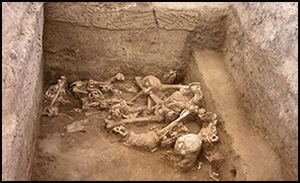Crossref Citations
This article has been cited by the following publications. This list is generated based on data provided by
Crossref.
Weninger, Bernhard
Clare, Lee
Jöris, Olaf
Jung, Reinhard
and
Edinborough, Kevan
2015.
Quantum theory of radiocarbon calibration.
World Archaeology,
Vol. 47,
Issue. 4,
p.
543.
Larsen, Clark Spencer
Hillson, Simon W.
Boz, Başak
Pilloud, Marin A.
Sadvari, Joshua W.
Agarwal, Sabrina C.
Glencross, Bonnie
Beauchesne, Patrick
Pearson, Jessica
Ruff, Christopher B.
Garofalo, Evan M.
Hager, Lori D.
Haddow, Scott D.
and
Knüsel, Christopher J.
2015.
Bioarchaeology of Neolithic Çatalhöyük: Lives and Lifestyles of an Early Farming Society in Transition.
Journal of World Prehistory,
Vol. 28,
Issue. 1,
p.
27.
Bayliss, Alex
Brock, Fiona
Farid, Shahina
Hodder, Ian
Southon, John
and
Taylor, R. E.
2015.
Getting to the Bottom of It All: A Bayesian Approach to Dating the Start of Çatalhöyük.
Journal of World Prehistory,
Vol. 28,
Issue. 1,
p.
1.
Furholt, Martin
2016.
Settlement layout and social organisation in the earliest European Neolithic.
Antiquity,
Vol. 90,
Issue. 353,
p.
1196.
Berger, Jean-Francois
Lespez, Laurent
Kuzucuoğlu, Catherine
Glais, Arthur
Hourani, Fuad
Barra, Adrien
and
Guilaine, Jean
2016.
Interactions between climate change and human activities during the early to
mid-Holocene in the eastern Mediterranean basins.
Climate of the Past,
Vol. 12,
Issue. 9,
p.
1847.
Haddow, Scott D.
Sadvari, Joshua W.
Knüsel, Christopher J.
and
Hadad, Rémi
2016.
Theoretical Approaches to Analysis and Interpretation of Commingled Human Remains.
p.
5.
Tasić, Nenad
Marić, Miroslav
Filipović, Dragana
Penezić, Kristina
Dunbar, Elaine
Reimer, Paula
Barclay, Alistair
Bayliss, Alex
Gaydarska, Bisserka
and
Whittle, Alasdair
2016.
Interwoven Strands for Refining the Chronology of the Neolithic Tell of Vinča-Belo Brdo, Serbia.
Radiocarbon,
Vol. 58,
Issue. 4,
p.
795.
Pilloud, Marin A.
Haddow, Scott D.
Knüsel, Christopher J.
and
Larsen, Clark Spencer
2016.
A bioarchaeological and forensic re-assessment of vulture defleshing and mortuary practices at Neolithic Çatalhöyük.
Journal of Archaeological Science: Reports,
Vol. 10,
Issue. ,
p.
735.
Flohr, Pascal
Fleitmann, Dominik
Matthews, Roger
Matthews, Wendy
and
Black, Stuart
2016.
Evidence of resilience to past climate change in Southwest Asia: Early farming communities and the 9.2 and 8.2 ka events.
Quaternary Science Reviews,
Vol. 136,
Issue. ,
p.
23.
Shillito, Lisa-Marie
2017.
Multivocality and multiproxy approaches to the use of space: lessons from 25 years of research at Çatalhöyük.
World Archaeology,
Vol. 49,
Issue. 2,
p.
237.
Lewis, Jonathan P.
Leng, Melanie J.
Dean, Jonathan R.
Marciniak, Arkadiusz
Bar-Yosef Mayer, Daniella E.
and
Wu, Xiaohong
2017.
Early Holocene palaeoseasonality inferred from the stable isotope composition of Unio shells from Çatalhöyük, Turkey.
Environmental Archaeology,
Vol. 22,
Issue. 1,
p.
79.
Radivojević, Miljana
Rehren, Thilo
Farid, Shahina
Pernicka, Ernst
and
Camurcuoğlu, Duygu
2017.
Repealing the Çatalhöyük extractive metallurgy: The green, the fire and the ‘slag’.
Journal of Archaeological Science,
Vol. 86,
Issue. ,
p.
101.
Nishiaki, Yoshihiro
Guliyev, Farhad
Kadowaki, Seiji
and
Omori, Takayuki
2018.
Neolithic residential patterns in the southern Caucasus: Radiocarbon analysis of rebuilding cycles of mudbrick architecture at Göytepe, west Azerbaijan.
Quaternary International,
Vol. 474,
Issue. ,
p.
119.
Hendy, Jessica
Colonese, Andre C.
Franz, Ingmar
Fernandes, Ricardo
Fischer, Roman
Orton, David
Lucquin, Alexandre
Spindler, Luke
Anvari, Jana
Stroud, Elizabeth
Biehl, Peter F.
Speller, Camilla
Boivin, Nicole
Mackie, Meaghan
Jersie-Christensen, Rosa R.
Olsen, Jesper V.
Collins, Matthew J.
Craig, Oliver E.
and
Rosenstock, Eva
2018.
Ancient proteins from ceramic vessels at Çatalhöyük West reveal the hidden cuisine of early farmers.
Nature Communications,
Vol. 9,
Issue. 1,
Makarowicz, Przemysław
Goslar, Tomasz
Niebieszczański, Jakub
Cwaliński, Mateusz
Kochkin, Igor T.
Romaniszyn, Jan
Lysenko, Sergiy D.
and
Ważny, Tomasz
2018.
Middle Bronze Age societies and barrow line chronology. A case study from the Bukivna ‘necropolis’, Upper Dniester Basin, Ukraine.
Journal of Archaeological Science,
Vol. 95,
Issue. ,
p.
40.
Kuijt, Ian
2018.
Material Geographies of House Societies: Reconsidering Neolithic Çatalhöyük, Turkey.
Cambridge Archaeological Journal,
Vol. 28,
Issue. 4,
p.
565.
Orton, David
Anvari, Jana
Gibson, Catriona
Last, Jonathan
Bogaard, Amy
Rosenstock, Eva
and
Biehl, Peter F.
2018.
A tale of two tells: dating the Çatalhöyük West Mound.
Antiquity,
Vol. 92,
Issue. 363,
p.
620.
Roffet-Salque, Mélanie
Marciniak, Arkadiusz
Valdes, Paul J.
Pawłowska, Kamilla
Pyzel, Joanna
Czerniak, Lech
Krüger, Marta
Roberts, C. Neil
Pitter, Sharmini
and
Evershed, Richard P.
2018.
Evidence for the impact of the 8.2-kyBP climate event on Near Eastern early farmers.
Proceedings of the National Academy of Sciences,
Vol. 115,
Issue. 35,
p.
8705.
Haddow, Scott D.
Tsoraki, Christina
Vasić, Milena
Dori, Irene
Knüsel, Christopher J.
and
Milella, Marco
2019.
An analysis of modified human teeth at Neolithic Çatalhöyük, Turkey.
Journal of Archaeological Science: Reports,
Vol. 28,
Issue. ,
p.
102058.
Greenfield, Haskel
and
Marciniak, Arkadiusz
2019.
Retention of old technologies following the end of the Neolithic: microscopic analysis of the butchering marks on animal bones from Çatalhöyük East.
World Archaeology,
Vol. 51,
Issue. 1,
p.
76.
